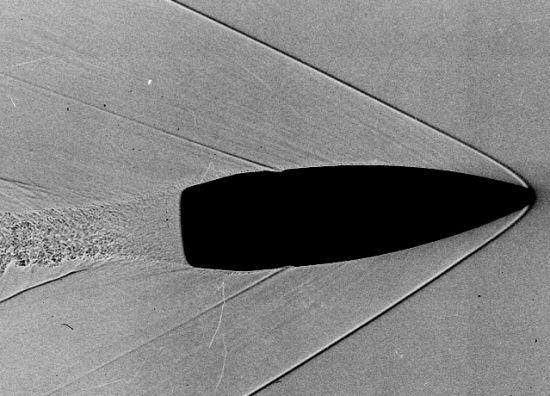|
||||||||||
|
|
||||||||||
|
||||||||||
|
|
||||||||||

Based on this photo, we can get some idea of the basic phenomenon that occur on a body traveling at supersonic speeds. Most notable is the strong shock wave that is created off of the nose of the bullet. This sort of shock wave is referred to as a bow shock, and it is so strong because the nose creates such a sudden discontinuity as the supersonic air flow encounters it. We also see a series of lines similar to shock waves that emanate from different regions along the body. These are compression and expansion waves. A compression wave is created when the cross-sectional area of the body increases, because the flow is squeezed into a smaller area and "compressed." If the compression is strong enough, this squeezing of the flow will result in a shock wave. For example, a series of compression waves can be seen near the middle of the above bullet. They form a large blurred region close to the bullet's surface but merge further out into a single line, indicating that they have merged to form a shock wave.
An expansion wave, on the other hand, is created when the cross-sectional area of the body decreases, because the flow can expand into a larger region. The flow is said to "fan out," which is why a series of expansion waves is often referred to as an expansion fan. Expansion fans can be seen in the above image towards the aft end of the bullet. Far outboard of the aft end of the bullet can also be seen two strong lines indicating a trailing shock. In addition, a region of very low pressure exists aft of the blunt bullet base giving rise to the turbulent wake we see trailing behind the bullet. A closer view exemplifying supersonic waves and wakes can be seen below.

We see similar phenomenon on aircraft traveling at supersonic speeds. A strong bow shock is generated off the
nosecone and another strong shock wave is created off the aft end of the aircraft. If you've ever heard an
aircraft traveling at Mach 1 or faster, you'll note that you don't hear just one sonic boom, but two booms in
rapid succesion. This "ba-boom" sound is actually the twin bow and trailing shock waves coming off the nose and
tail of the plane. In addition, shock waves form off of any sudden discontinuities or changes in the shape of
the vehicle. This concept of a "discontinuous" distribution in the cross-sectional area of a body is a key
principal in the Area Rule. This rule relates to how discontinuities in the shape of an
aircraft create drag.
- answer by Joe Yoon, 21 April 2002
Read More Articles:


|
Aircraft | Design | Ask Us | Shop | Search |

|
|
| About Us | Contact Us | Copyright © 1997- | |||
|
|
|||